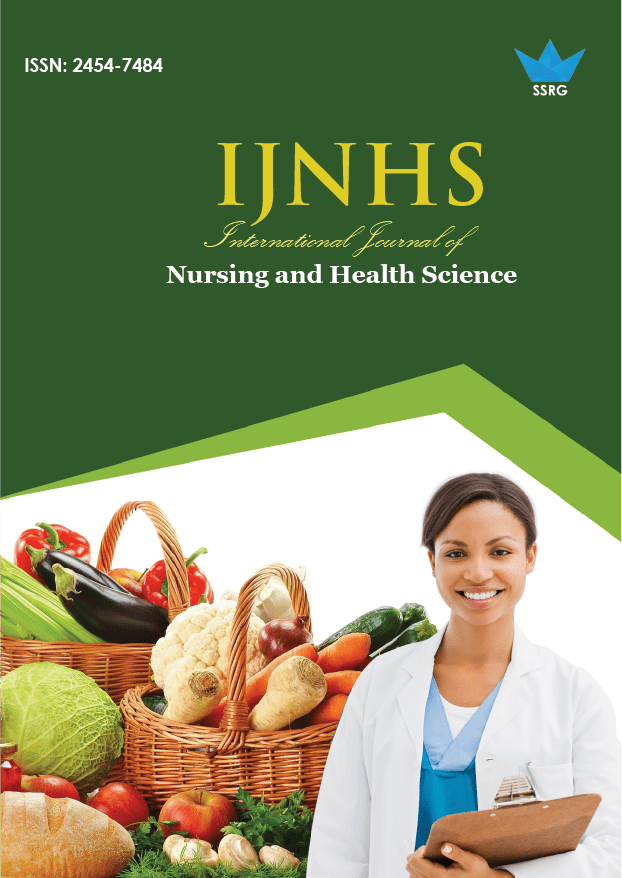Review of Documentation Status of Modified WHO Partograph in 47 Emergency Obstetric and Newborn Centers (EmONC) of Bhutan in 2018

| International Journal of Nursing and Health Science |
| © 2021 by SSRG - IJNHS Journal |
| Volume 7 Issue 1 |
| Year of Publication : 2021 |
| Authors : Deki Pem, Tashi Tshomo, Karma Jurmin, Karma Tshering, Pema Lethro |
How to Cite?
Deki Pem, Tashi Tshomo, Karma Jurmin, Karma Tshering, Pema Lethro, "Review of Documentation Status of Modified WHO Partograph in 47 Emergency Obstetric and Newborn Centers (EmONC) of Bhutan in 2018," SSRG International Journal of Nursing and Health Science, vol. 7, no. 1, pp. 20-23, 2021. Crossref, https://doi.org/10.14445/24547484/IJNHS-V7I1P105
Abstract:
A. Background: The country-wide Emergency Obstetric and Newborn Care (EmONC) assessment was conducted in 47 health facilities in Bhutan. This study aimed to assess the documentation status of the modified WHO Partograph.
B. Methods: A total of 116 partograph were reviewed last six months prior to the study period.
C. Results: The overall completeness of the partograph was only 6.0%, where the commonly plotted section was uterine contraction and descent of the fetal head with 89.7% and 87.1%, respectively. More than 50% of records of maternal well-being were missing from the partograph.
D. Conclusion: The National MidwiferyStandard2018 mandates to use of partograph as one of the important components of intrapartum care to monitor the progress of labor and fetal and maternal well-being. However, the completeness of the partograph was extremely low, which is a concern of the quality of obstetric care in the country. There is a need for enhancement of knowledge and skills of health care providers in recording the progress of labor and maternal and fetal wellbeing in the partograph. Further, the recommendation is to identify the theory and practice gap and to strengthen monitoring and evaluation.
Keywords:
Bhutan, newborn, maternal health, modified WHO partograph
References:
[1] World Health Organization. Intrapartum care for a positive childbirth experience [Internet]. 2018. 212 p. Available from: http://apps.who.int/iris/bitstream/10665/260178/1/9789241550215-eng.pdf?ua=1%0Ahttp://www.who.int/reproductivehealth/publications/intrapartum-care-guidelines/en/
[2] World Health Organisation. Education material for teachers of midwifery. (2008). Available from: https://apps.who.int/iris/bitstream/handle/10665/44145/9789241546669_1_eng.pdf?sequence=1
[3] Ollerhead E, Osrin D. Barriers to and incentives for achieving partograph use in obstetric practice in low-and middle-income countries: A systematic review. BMC Pregnancy Childbirth. 14(1) (2014)1–7.
[4] Mukisa J, Grant I, Magala J, Ssemata AS, Lumala PZ, Byamugisha J. Level of Partograph completion and healthcare workers’ perspectives on its use in Mulago National Referral and teaching hospital, Kampala, Uganda. BMC Health Serv Res.19(1) (2019)1–8.
[5] Hailu T, Nigus K, Gidey G, Hailu B, Moges Y. Assessment of partograph utilization and associated factors among obstetric care givers at public health institutions in the central zone, Tigray, Ethiopia. BMC Res Notes [Internet]. 11(1) (2018) 1–6. Available from: https://doi.org/10.1186/s13104-018-3814-7
[6] Engida Y, Berhanu D, Ayalew A NF. (PDF) Knowledge and utilization of partograph among obstetric care givers in public health institutions of Addis Ababa, Ethiopia _ Academic Article. (2010)1–9.
[7] Opoku BK, Nguah SB. Utilization of the modified WHO partograph in assessing the progress of labor in a metropolitan area in Ghana. Res J Women’s Heal. 2(1) (2015) 2.
[8] K, Pokhrel HP, Dorji K, Rinzin D. Knowledge of Partograph Recording and Interpretation and Its Documentation Status in
Samdrup Jongkhar District, Bhutan. Int J Innov Res Med Sci. 3(12) (2018) 2356–60.
[9] Khan ANS, Billah SM, Mannan I, Mannan II, Begum T, Khan MA, et al. A cross-sectional study of partograph utilization as a decision-making tool for referral of abnormal labor in primary health care facilities of Bangladesh. PLoS One [Internet]. 13(9) (2018) 1–18. Available from: http://dx.doi.org/10.1371/journal.pone.0203617
[10] Dorji P, Lethro P, Tshering L, Tshomo T. Situation of maternal health in Bhutan 2018. Bhutan Health Journal, (2018) 39.
[11] Yisma E, Dessalegn B, Astatkie A, Fesseha N. Completion of the modified World Health Organization (WHO) partograph during labor in public health institutions of Addis Ababa, Ethiopia. Reprod Health. (2013) 10(1).
[12] Family care internaitonal. Strengthening Provider Competencies. 2005;(June). Available from: http://www.tzonline.org/pdf/strengtheningprovidercompetenciesandperformance.pdf
[13] Mailman School of Public Health, Averting Maternal Death and DisabilityProgram (AMDD); Needs Assessments of Emergency Obstetric and Newborn Care Overview an Introduction to Materials. Columbia University, New York, USA, (2009).

 10.14445/24547484/IJNHS-V7I1P105
10.14445/24547484/IJNHS-V7I1P105